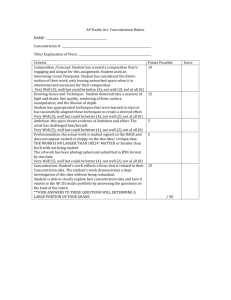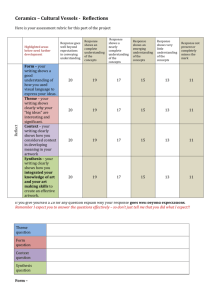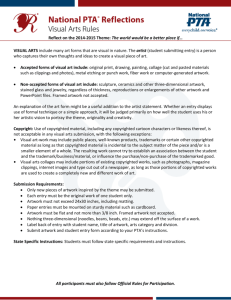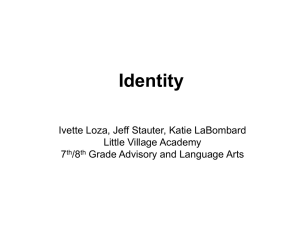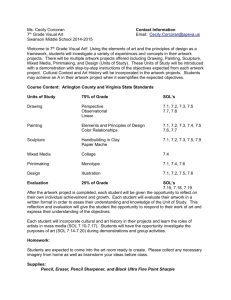CLICK HERE for the Grading Rubric
advertisement
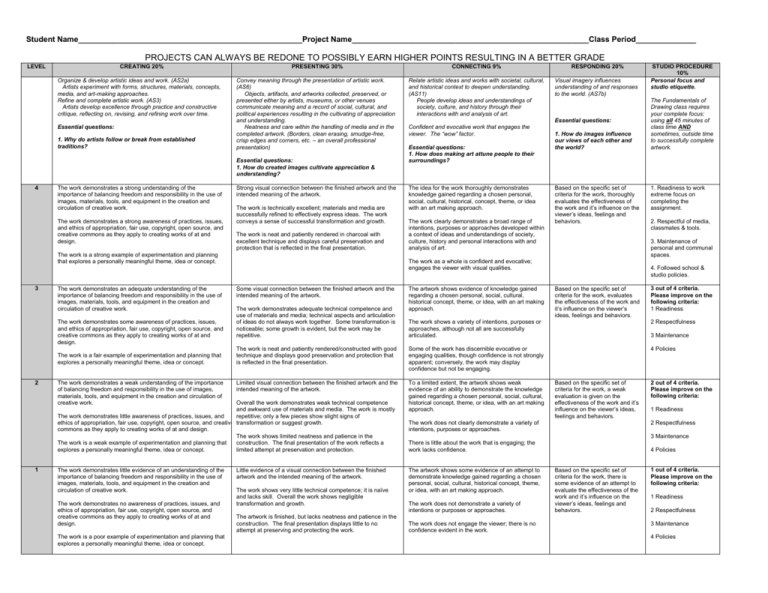
Student Name____________________________________________________Project Name_______________________________________________________Class Period______________ PROJECTS CAN ALWAYS BE REDONE TO POSSIBLY EARN HIGHER POINTS RESULTING IN A BETTER GRADE LEVEL CREATING 20% Organize & develop artistic ideas and work. (AS2a) Artists experiment with forms, structures, materials, concepts, media, and art-making approaches. Refine and complete artistic work. (AS3) Artists develop excellence through practice and constructive critique, reflecting on, revising, and refining work over time. Essential questions: 1. Why do artists follow or break from established traditions? PRESENTING 30% CONNECTING 9% RESPONDING 20% Convey meaning through the presentation of artistic work. (AS6) Objects, artifacts, and artworks collected, preserved, or presented either by artists, museums, or other venues communicate meaning and a record of social, cultural, and political experiences resulting in the cultivating of appreciation and understanding. Neatness and care within the handling of media and in the completed artwork. (Borders, clean erasing, smudge-free, crisp edges and corners, etc. – an overall professional presentation) Relate artistic ideas and works with societal, cultural, and historical context to deepen understanding. (AS11) People develop ideas and understandings of society, culture, and history through their interactions with and analysis of art. Visual imagery influences understanding of and responses to the world. (AS7b) Essential questions: 1. How do created images cultivate appreciation & understanding? 4 The work demonstrates a strong understanding of the importance of balancing freedom and responsibility in the use of images, materials, tools, and equipment in the creation and circulation of creative work. The work demonstrates a strong awareness of practices, issues, and ethics of appropriation, fair use, copyright, open source, and creative commons as they apply to creating works of at and design. Strong visual connection between the finished artwork and the intended meaning of the artwork. The work is technically excellent; materials and media are successfully refined to effectively express ideas. The work conveys a sense of successful transformation and growth. The work is neat and patiently rendered in charcoal with excellent technique and displays careful preservation and protection that is reflected in the final presentation. The work is a strong example of experimentation and planning that explores a personally meaningful theme, idea or concept. 3 The work demonstrates an adequate understanding of the importance of balancing freedom and responsibility in the use of images, materials, tools, and equipment in the creation and circulation of creative work. The work demonstrates some awareness of practices, issues, and ethics of appropriation, fair use, copyright, open source, and creative commons as they apply to creating works of at and design. The work is a fair example of experimentation and planning that explores a personally meaningful theme, idea or concept. 2 The work demonstrates a weak understanding of the importance of balancing freedom and responsibility in the use of images, materials, tools, and equipment in the creation and circulation of creative work. The work demonstrates little evidence of an understanding of the importance of balancing freedom and responsibility in the use of images, materials, tools, and equipment in the creation and circulation of creative work. The work demonstrates no awareness of practices, issues, and ethics of appropriation, fair use, copyright, open source, and creative commons as they apply to creating works of at and design. The work is a poor example of experimentation and planning that explores a personally meaningful theme, idea or concept. Essential questions: 1. How does making art attune people to their surroundings? The idea for the work thoroughly demonstrates knowledge gained regarding a chosen personal, social, cultural, historical, concept, theme, or idea with an art making approach. The work clearly demonstrates a broad range of intentions, purposes or approaches developed within a context of ideas and understandings of society, culture, history and personal interactions with and analysis of art. 1. How do images influence our views of each other and the world? Based on the specific set of criteria for the work, thoroughly evaluates the effectiveness of the work and it’s influence on the viewer’s ideas, feelings and behaviors. Some visual connection between the finished artwork and the intended meaning of the artwork. The work demonstrates adequate technical competence and use of materials and media; technical aspects and articulation of ideas do not always work together. Some transformation is noticeable; some growth is evident, but the work may be repetitive. The artwork shows evidence of knowledge gained regarding a chosen personal, social, cultural, historical concept, theme, or idea, with an art making approach. The Fundamentals of Drawing class requires your complete focus: using all 45 minutes of class time AND sometimes, outside time to successfully complete artwork. 1. Readiness to work extreme focus on completing the assignment. 2. Respectful of media, classmates & tools. 3. Maintenance of personal and communal spaces. The work as a whole is confident and evocative; engages the viewer with visual qualities. 4. Followed school & studio policies. Based on the specific set of criteria for the work, evaluates the effectiveness of the work and it’s influence on the viewer’s ideas, feelings and behaviors. 3 out of 4 criteria. Please improve on the following criteria: 1 Readiness The work shows a variety of intentions, purposes or approaches, although not all are successfully articulated. 2 Respectfulness The work is neat and patiently rendered/constructed with good technique and displays good preservation and protection that is reflected in the final presentation. Some of the work has discernible evocative or engaging qualities, though confidence is not strongly apparent; conversely, the work may display confidence but not be engaging. 4 Policies Limited visual connection between the finished artwork and the intended meaning of the artwork. To a limited extent, the artwork shows weak evidence of an ability to demonstrate the knowledge gained regarding a chosen personal, social, cultural, historical concept, theme, or idea, with an art making approach. Overall the work demonstrates weak technical competence and awkward use of materials and media. The work is mostly The work demonstrates little awareness of practices, issues, and repetitive; only a few pieces show slight signs of ethics of appropriation, fair use, copyright, open source, and creative transformation or suggest growth. commons as they apply to creating works of at and design. The work shows limited neatness and patience in the The work is a weak example of experimentation and planning that construction. The final presentation of the work reflects a explores a personally meaningful theme, idea or concept. limited attempt at preservation and protection. 1 Essential questions: Confident and evocative work that engages the viewer. The “wow” factor. STUDIO PROCEDURE 10% Personal focus and studio etiquette. Little evidence of a visual connection between the finished artwork and the intended meaning of the artwork. The work shows very little technical competence; it is naïve and lacks skill. Overall the work shows negligible transformation and growth. The artwork is finished, but lacks neatness and patience in the construction. The final presentation displays little to no attempt at preserving and protecting the work. 3 Maintenance Based on the specific set of criteria for the work, a weak evaluation is given on the effectiveness of the work and it’s influence on the viewer’s ideas, feelings and behaviors. The work does not clearly demonstrate a variety of intentions, purposes or approaches. 2 out of 4 criteria. Please improve on the following criteria: 1 Readiness 2 Respectfulness 3 Maintenance There is little about the work that is engaging; the work lacks confidence. The artwork shows some evidence of an attempt to demonstrate knowledge gained regarding a chosen personal, social, cultural, historical concept, theme, or idea, with an art making approach. The work does not demonstrate a variety of intentions or purposes or approaches. The work does not engage the viewer; there is no confidence evident in the work. 4 Policies Based on the specific set of criteria for the work, there is some evidence of an attempt to evaluate the effectiveness of the work and it’s influence on the viewer’s ideas, feelings and behaviors. 1 out of 4 criteria. Please improve on the following criteria: 1 Readiness 2 Respectfulness 3 Maintenance 4 Policies Student Name____________________________________________________Project Name_______________________________________________________Class Period______________ PROJECTS CAN ALWAYS BE REDONE TO POSSIBLY EARN HIGHER POINTS RESULTING IN A BETTER GRADE What was the goal of creating this particular piece of art? What is an area of this artwork that works well? Explain why it works well. What is an area that needs to be worked on? Explain why it needs to be reworked. At this point in the class, what are your creative strengths? At this point in the class, what do you need to work on to become a better artist? What do you want to focus on improving for the next piece of art?


